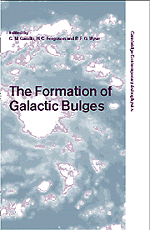Book contents
- Frontmatter
- Contents
- Preface
- Dedication: In Memory of Olin Eggen
- Part 1 Introduction
- Part 2 The Epoch of Bulge Formation
- Part 3 The Timescales of Bulge Formation
- Part 4 Physical Processes in Bulge Formation
- Part 5 Bulge Phenomenology
- Bulge-Disk Decomposition of Spiral Galaxies in the Near-Infrared
- The Triaxial Bulge of NGC 1371
- The Bulge-Disk Orthogonal Decoupling in Galaxies: NGC 4698 and NGC 4672
- The Kinematics and the Origin of the Ionized Gas in NGC 4036
- Optically Thin Thermal Plasma in the Galactic Bulge
- X-Ray Properties of Bulges
- The Host Galaxies of Radio-Loud AGN
- The Centers of Radio-Loud Early-Type Galaxies with HST
- Central UV Spikes in Two Galactic Spheroids
- Part 6 Conference Summary
- Index
X-Ray Properties of Bulges
from Part 5 - Bulge Phenomenology
Published online by Cambridge University Press: 10 November 2010
- Frontmatter
- Contents
- Preface
- Dedication: In Memory of Olin Eggen
- Part 1 Introduction
- Part 2 The Epoch of Bulge Formation
- Part 3 The Timescales of Bulge Formation
- Part 4 Physical Processes in Bulge Formation
- Part 5 Bulge Phenomenology
- Bulge-Disk Decomposition of Spiral Galaxies in the Near-Infrared
- The Triaxial Bulge of NGC 1371
- The Bulge-Disk Orthogonal Decoupling in Galaxies: NGC 4698 and NGC 4672
- The Kinematics and the Origin of the Ionized Gas in NGC 4036
- Optically Thin Thermal Plasma in the Galactic Bulge
- X-Ray Properties of Bulges
- The Host Galaxies of Radio-Loud AGN
- The Centers of Radio-Loud Early-Type Galaxies with HST
- Central UV Spikes in Two Galactic Spheroids
- Part 6 Conference Summary
- Index
Summary
Integrated X-ray observations of early-type spirals and detailed observations of the bulge of M31 suggest a complex picture of the X-ray emission of bulges. There is a baseline population of point-like X-ray sources, most likely accretion binaries, which is seen to dominate the emission of the bulge of M31. There are also spectral results suggesting an additional gaseous emission component in some X-ray bright galaxies. Future deep observations with the Chandra X-ray Observatory (CXO) will allow us to shed light on the nature of the X-ray emission.
Introduction
The nature of the X-ray emission of early-type, prominent-bulge spirals has been the subject of an on-going controversy, which has sought to establish if and how much of this emission can be ascribed to thermal emission of an optically thin hot gaseous medium. This is an important issue, because if it can be established that the X-ray emission is dominated by gravity-bound gaseous halos, the X-ray data may be used to measure the mass of these galaxies (see review in Fabbiano 1989).
In what follows, I give a summary of the work on this subject, and point out future opportunities.
A Brief History of X-ray Studies of Early-type Spirals
With the clear exception of M31, most of the bulges of early-type spirals could not be studied in detail with X-ray observatories, starting with the Einstein Observatory, in the early ʾ80s, and including all the facilities in orbit and operational at this time.
- Type
- Chapter
- Information
- The Formation of Galactic Bulges , pp. 180 - 182Publisher: Cambridge University PressPrint publication year: 2000



